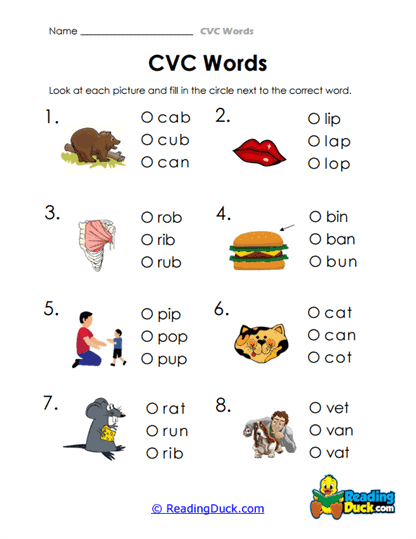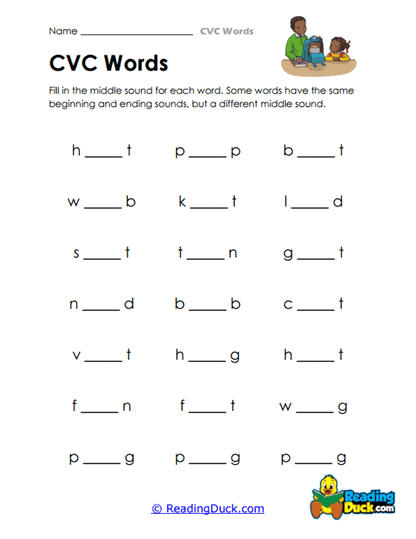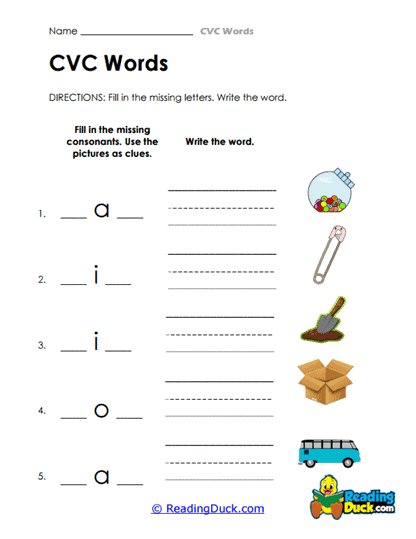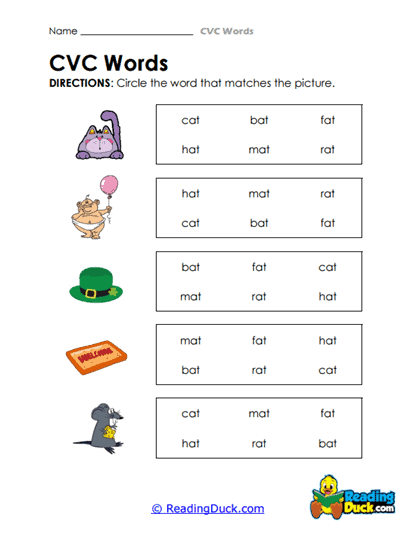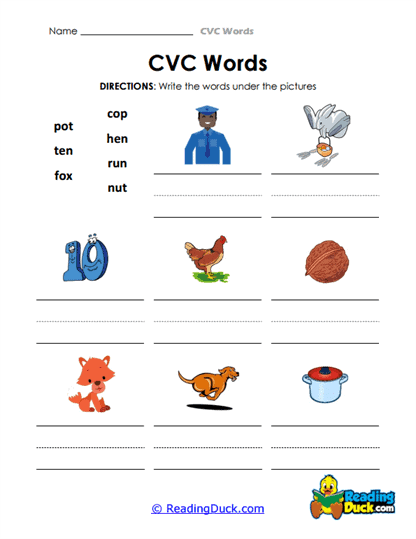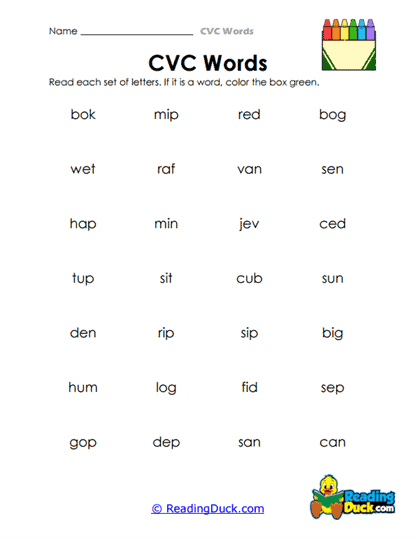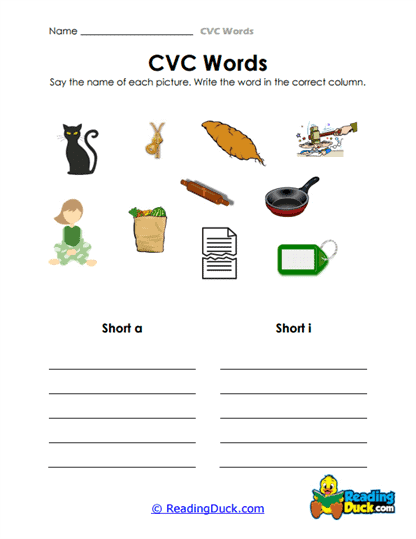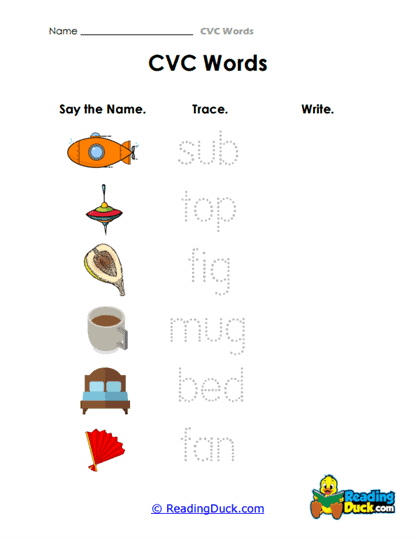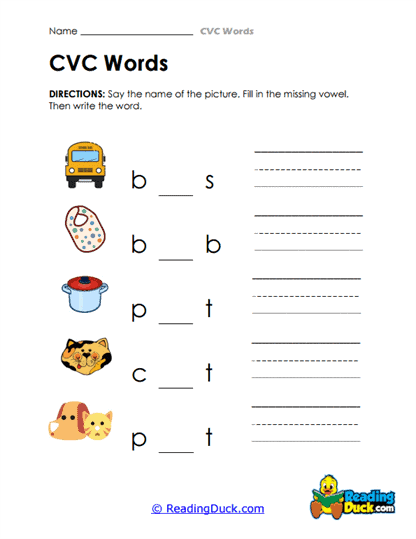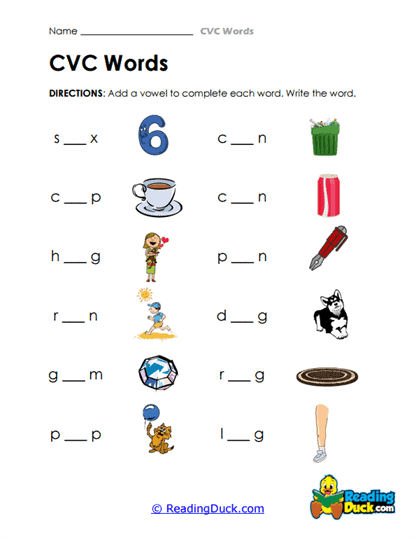CVC Words Worksheets
About Our CVC Words Worksheets
Our collection of CVC (Consonant-Vowel-Consonant) Words Worksheets is an essential resource within the 'Phonics' category of the 'Pre-Reading' section, designed to support early reading skills in young learners. These worksheets focus on helping children recognize, decode, and spell simple CVC words, laying the groundwork for more advanced reading and writing abilities. Available in convenient PDF format, these worksheets are easy to view, download, and print, making them ideal for both classroom and homeschool settings. To further assist educators, each worksheet includes a downloadable answer key, ensuring that teaching and assessment are both efficient and effective.
Understanding CVC Words and Their Importance in Early Literacy
CVC words are a fundamental component of early literacy, serving as one of the first building blocks in a child's journey to becoming a proficient reader. As a professional licensed teacher specializing in pre-reading skills, it's important to understand what CVC words are, why they matter, and how they contribute to a child's overall reading development.
What Are CVC Words?
- Definition: CVC words are simple three-letter words that follow a consonant-vowel-consonant pattern, such as "cat," "dog," and "pen." These words are typically among the first that young learners encounter as they begin to read independently.
- Simplicity in Structure: The simplicity of CVC words lies in their straightforward structure, which makes them easy for young children to decode and pronounce. Each letter represents a distinct sound, helping learners understand the relationship between letters and sounds (phonemes).
- Foundation for Phonics: CVC words are a critical part of phonics instruction because they introduce children to the concept of blending sounds together to form words. Mastery of CVC words provides a solid foundation for reading more complex words and sentences.
Importance of CVC Words in Early Reading Development:
- Phonemic Awareness: CVC words help children develop phonemic awareness, which is the ability to hear, identify, and manipulate individual sounds in spoken words. This skill is crucial for learning to read and spell.
- Decoding Skills: Learning CVC words enhances a child's decoding skills, enabling them to sound out new words based on their knowledge of letter-sound correspondences. This is a key step in moving from recognizing letters to reading fluently.
- Confidence Building: Successfully reading and spelling CVC words boosts a child's confidence in their reading abilities. This sense of achievement encourages them to tackle more challenging texts as they progress.
- Vocabulary Development: Although CVC words are simple, they form the foundation for a child's early vocabulary. Understanding and using these words in context helps children build a broader vocabulary, which is essential for comprehension and communication.
Examples of CVC Words and Their Role in Literacy:
- Blending Sounds: For example, in the word "bat," children learn to blend the sounds /b/ /a/ /t/ together to form the word. This blending process is fundamental to reading and spelling.
- Word Families: CVC words often belong to word families, such as "cat," "hat," "rat," and "mat." Recognizing patterns in word families helps children understand that words can share common sounds and spellings, which simplifies the reading process.
How These Worksheets Support the Learning and Practice of CVC Words
Our CVC Words Worksheets are carefully designed to support young learners in recognizing, practicing, and mastering the concept of CVC words.
Developmentally Appropriate Practice:
- Progressive Learning: The worksheets are likely organized to introduce CVC words in a structured manner, gradually increasing in complexity as children become more comfortable with the basic CVC pattern. This allows learners to build their skills step by step, ensuring a solid understanding of each concept before moving on to the next.
- Reinforcement of Phonemic Awareness: Through repeated exposure to CVC words, these worksheets help reinforce phonemic awareness. Children practice isolating and blending sounds, which strengthens their ability to decode unfamiliar words.
- Support for Spelling and Writing: In addition to reading, the worksheets may also encourage children to practice spelling and writing CVC words. This dual focus on reading and writing helps solidify the connection between spoken and written language.
Encouraging Independent Learning:
- Self-Paced Practice: The worksheets can be used for independent practice, allowing children to work at their own pace. This self-directed learning helps build confidence as children see their progress over time.
- Visual and Auditory Learning: By incorporating both visual and auditory elements, the worksheets cater to different learning styles. Visual learners benefit from seeing the words and pictures, while auditory learners gain from sounding out the words.
Strategies for Teaching CVC Words Effectively
Teaching CVC words to young learners requires a strategic and thoughtful approach to ensure that children grasp the concept and can apply it confidently in their reading and writing. Here are some suggestions on how educators can introduce and teach CVC words effectively:
Introducing CVC Words:
- Start with Letter Sounds: Before introducing CVC words, ensure that children are familiar with the individual letter sounds. This foundational knowledge is crucial for blending sounds together to form words.
- Use Multisensory Approaches: Engage children with multisensory activities that involve seeing, hearing, and touching. For example, use magnetic letters to form CVC words, allowing children to physically manipulate the letters as they sound them out.
- Introduce Word Families: Start with a specific word family, such as "-at" (cat, bat, hat), to help children recognize patterns and similarities between words. This pattern recognition makes it easier for them to decode new words.
Helping Students Master CVC Words:
- Blending Practice: Encourage frequent practice of blending sounds to form CVC words. Use oral activities where children say the sounds slowly and then blend them together to say the whole word.
- Visual Aids: Incorporate visual aids, such as flashcards with pictures and corresponding CVC words, to help children connect the written word with its meaning. This visual connection enhances comprehension.
- Interactive Reading: During storytime, pause to point out CVC words in the text and encourage children to sound them out. This reinforces the skill in a real-world context and helps children see the relevance of what they are learning.
Practical Tips for Using CVC Words Worksheets Effectively
To maximize the benefits of CVC Words Worksheets, educators and parents can follow these practical tips, ensuring that young learners gain the most from these resources.
Incorporating Worksheets into Daily Practice:
- Morning Literacy Centers: Use the worksheets as part of a morning literacy center where children can independently or in small groups practice their CVC words. This routine helps solidify their understanding and creates a consistent learning environment.
- Homework Assignments: Assign worksheets as homework to reinforce the day's lessons. This not only provides additional practice but also involves parents in their child's learning process.
- Small Group Instruction: During small group sessions, use the worksheets to provide targeted instruction. This setting allows for more personalized feedback and guidance, helping each child progress at their own pace.
Supplementary Activities to Reinforce Learning:
- CVC Word Games: Incorporate fun games that involve CVC words, such as bingo or matching games. These activities make learning enjoyable and reinforce the skills in a playful manner.
- Writing Practice: Encourage children to write simple sentences using CVC words they have learned. For example, "The cat sat on the mat." This practice helps them apply their knowledge in context.
- Interactive Storytelling: Use CVC words in storytelling activities where children create their own stories using the words they have learned. This not only reinforces their understanding but also stimulates their creativity.
Building Confidence and Literacy Skills with CVC Words Worksheets
In conclusion, the CVC Words Worksheets within the 'Phonics' category of the 'Pre-Reading' section are a crucial resource for building foundational literacy skills in young learners, particularly those in kindergarten through first grade. By focusing on the recognition, decoding, and spelling of CVC words, these worksheets play a vital role in helping children develop the phonemic awareness and decoding skills necessary for reading success.
These worksheets are not just about rote practice; they are a means of empowering children to become confident readers who can independently decode and understand simple words. With the right approach, educators and parents can use these worksheets to create a supportive and engaging learning environment that fosters a love of reading and prepares children for more advanced literacy challenges.
By integrating these worksheets into daily practice, supplementing them with interactive activities, and providing consistent support and encouragement, you can help your students master CVC words and set them on a path to reading proficiency. Whether used in a classroom or homeschool setting, these worksheets are an invaluable tool in the early stages of a child's literacy journey.
